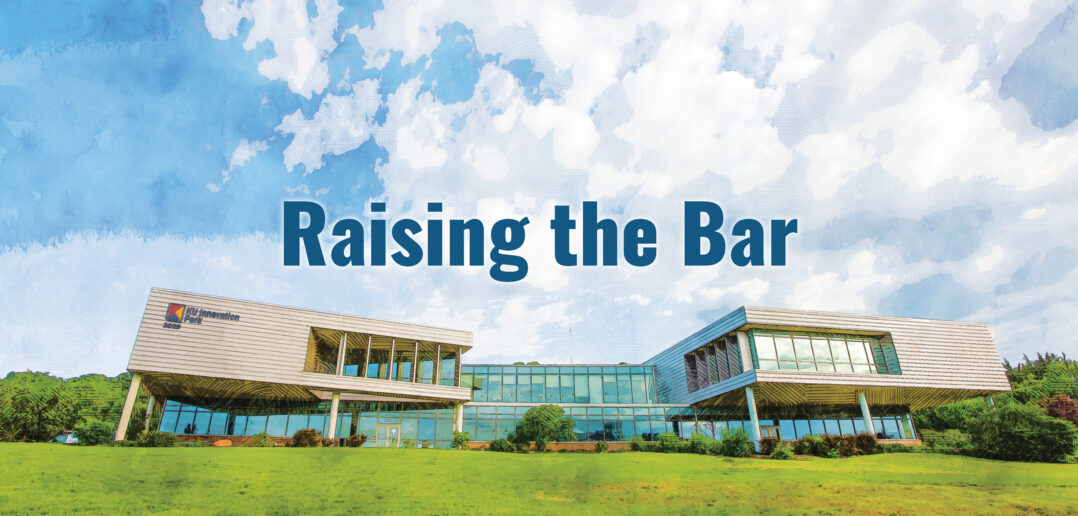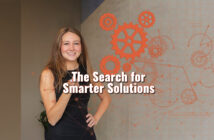| story by | |
| photos by | Steven Hertzog |
| OPEN A PDF OF THE ARTICLE |
Expansion is on the horizon for KU Innovation Park both locally and beyond, and the economic benefit to the Lawrence community is undeniable.
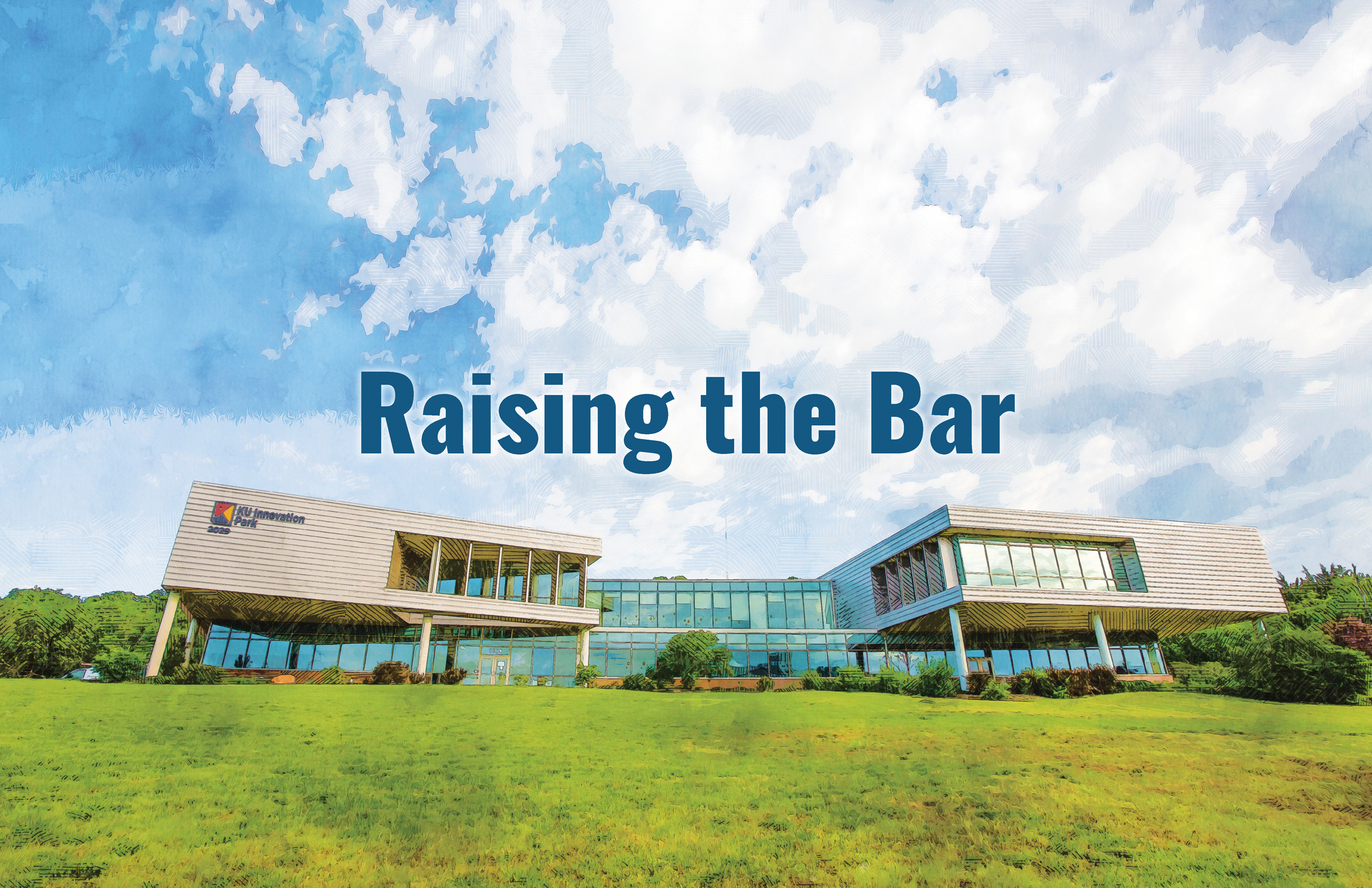
Innovation Park
Who is, and what is, KU Innovation Park? KU Innovation Park is a yearslong, uniquely unified partnership among four entities, the four very things that define its location, to be exact: the City of Lawrence, Douglas County, the Lawrence Chamber of Commerce and, of course, the monikered University of Kansas (KU).
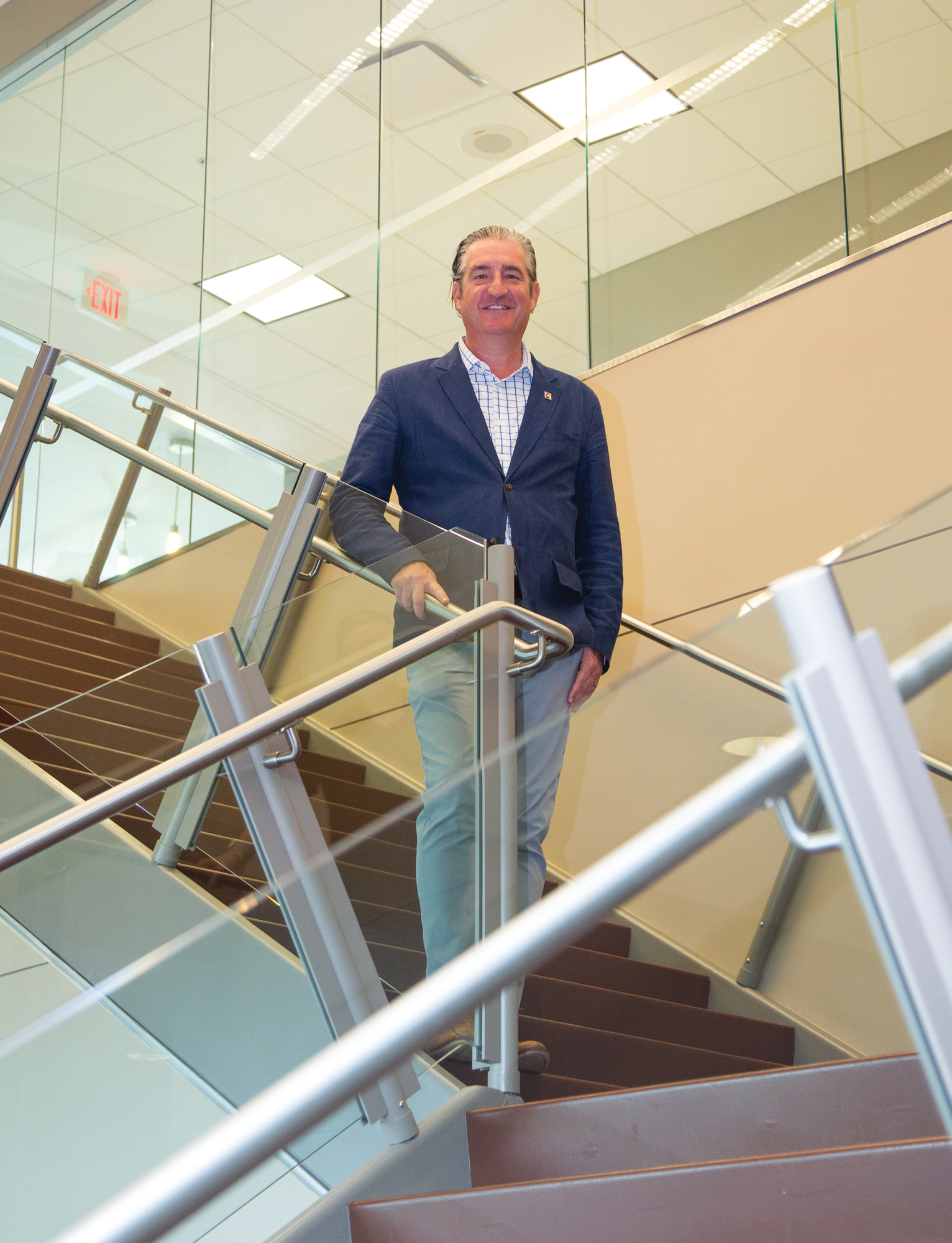
CEO Adam Courtney
The park’s reach and impact emanate far beyond its, and even the county’s, borders. Businesses and research in the park have expanded statewide. And, with recent announcements about its latest phase, the technology, methodology and commerce developed in the park will soon extend to the entire nation.
Having played a part in the success of 72 companies since the construction of its first phase in 2010, the park has arrived at the stage where its incremental success in the earlier years has built to exponential realities at the midpoint of 2024.
CEO Adam Courtney says that uniting private companies with the assets of a large research university on neutral property where everyone retains their own intellectual property benefits everyone involved. Companies can access high-tech laboratories and facilities; the city and county gain local jobs and reap economic benefits; and the university faculty and students participate in and experience high-level, real-world research.
“We provide resources, and we tap into the university or the community to fill the gaps. We are engaged with our companies, and we understand what they’ll need,” Courtney explains.
Companies at KU Innovation Park fit one of three categories, he continues. The majority of companies are startups, which need, at minimum, a location and an address but also may capitalize on dry lab or wet lab space for research, technological infrastructure at the park and expertise in their fields at the university. Other companies may be newly launched companies, past the startup phase but still early in development, from abroad or from out of state that are looking for a regional presence and specialized talent. More recently, Fortune 500 companies have come to the park seeking early access to talented new graduates, as well as to grow their research bases and collaborate with the university.
LOCAL MATTERS
Our Local Advertisers – Making a Positive Impact
KU Innovation Park’s local economic impacts cannot be overstated, and the effects are deep, wide and longitudinally beneficial. The companies’ total annual payroll in 2024, for example, is $46 million, Courtney says. What—and whom—the park lures to Lawrence broadens the economic base, and it broadens the experiences available to faculty and students at KU.
“We’re a community asset and not only a university asset. We put our heads down for the first 10 years and created companies and created results. Now we’re growing the awareness that there are a lot of people in tech in the community,” he adds.
Tricia Bergman, KU associate vice chancellor for economic development, functions as a funnel through which companies, the community and the university exchange ideas and resources to build into research partnerships and corporate opportunities. She draws on existing community resources, academic opportunities and industry to help create and maintain the university’s relationships with the park and its companies.
“From an entrepreneurial perspective, a startup inside the university can move to the park and get services within the park. We look at what aspects of the university can help them grow,” Bergman says. “We take the research and the new ideas that students and faculty have, and how do we take those outside the university and provide an infrastructure that supports them?”
At the same time, she works to connect the park’s companies with researchers and research teams inside the university, bringing companies the experts in their given field, while connecting students with real-world experiences that can lead them to potential employment.
“On the KU campus, we have a large number of core labs with high-dollar analytical capability. The university has the equipment and scientists who can run it, and the entrepreneurs can’t afford that on their own. They can partner directly on federal opportunities, or they sponsor research with a faculty member,” Bergman explains.
It isn’t only proximity to the university that is critical and helpful to the companies, though; working near one another allows for conversations and more among the companies themselves—from startups to the more established.
“We know that the density and proximity are important. They’re all trying to solve similar problems. Some of the benefits of being here are lessons learned,” Courtney says. “Creative collisions are important for the things they’re working on. A central location where they can collaborate and host customers is still in demand.”
Bergman agrees that networking among the companies is part of what raises the bar for KU Innovation Park.
“Companies large and small can share experiences, share talent and help each other out. That density of companies being next to each other and next to the university, that’s a wonderful accelerator of growth,” she adds.
From the Beginning to Today
Discussions of what would become KU Innovation Park began in 2005, when representatives from the city, county, chamber of commerce and the university met in an effort to capitalize on the state’s burgeoning identity as a bioscience hub.
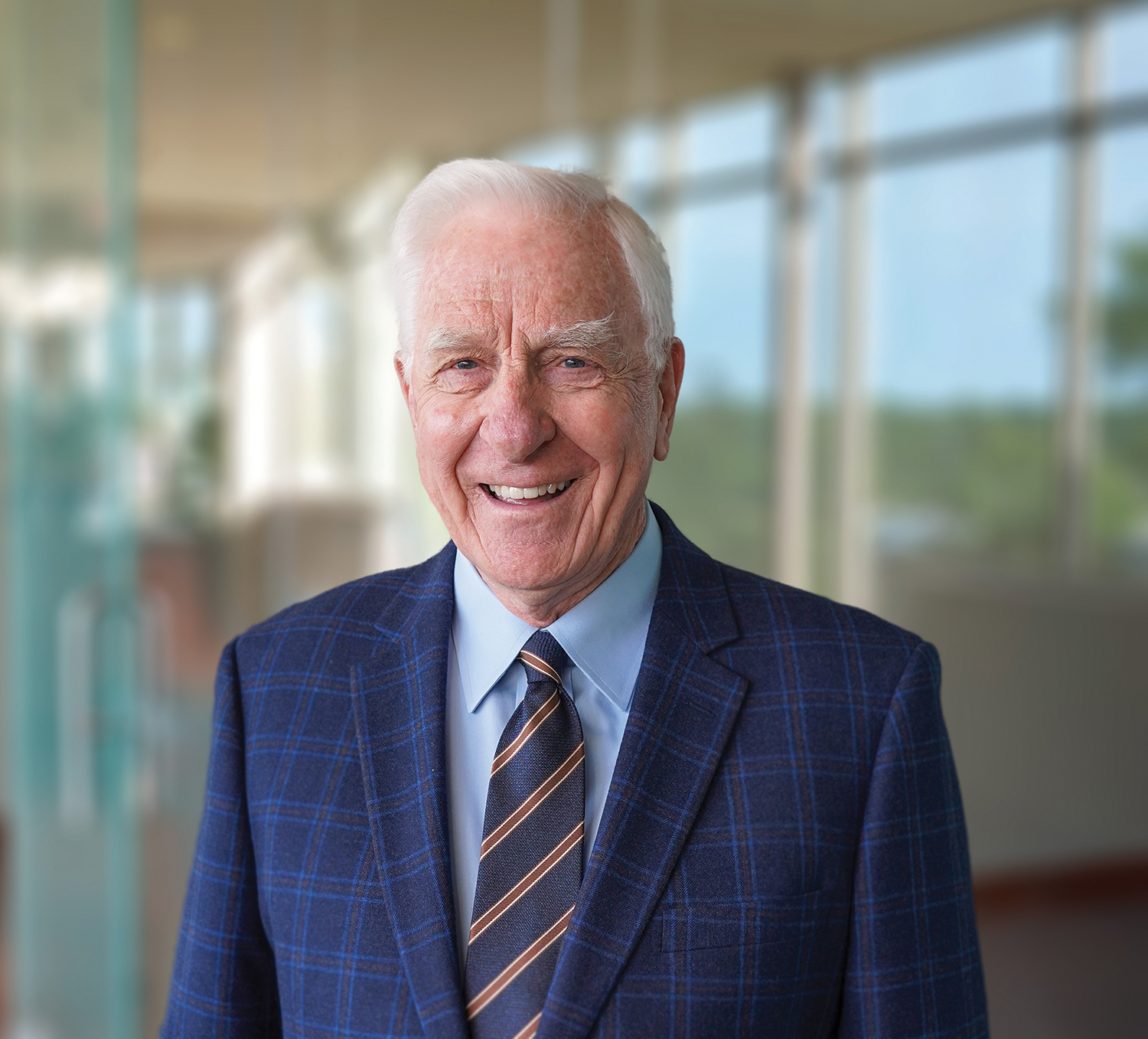
Bob Johnson
Bob Johnson was a county commissioner at the time and says the group’s commitment to working together was what made it successful from the beginning.
“We decided that whoever spoke going forward would be the first among equals. We kept that commitment, and now it has been transformational for the community and the state of Kansas,” he explains.
The decisions made collectively by that initial group since 2005 have transcended through three KU chancellors, multiple Lawrence city managers and Chamber leaders, and two county executives.
“To keep all those successive people committed to the idea and operating collaboratively and collectively, it’s really remarkable,” Johnson adds.
He credits Laverne Epp, who headed up Phase I (then called the Bioscience & Technology Business Center, or BTBC), with managing the communications and expectations of both internal and external people, as well as with raising the profile.
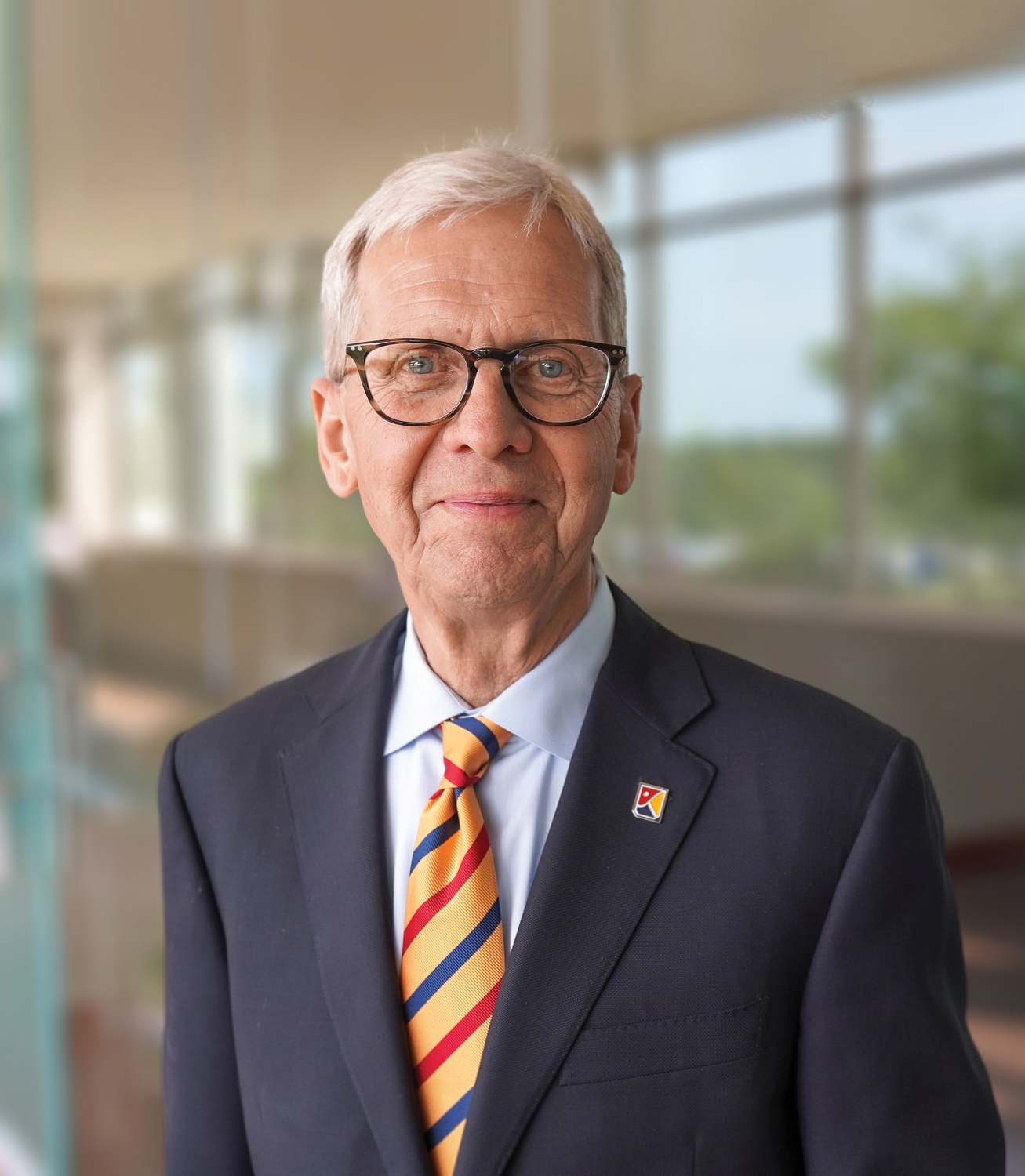
Laverne Epp
That first phase saw the BTBC’s 25,000-square-foot building, now called the Main Facility at the park, open in 2010 and fill to capacity within 18 months, Courtney explains, which validated the idea.
Phase II, an additional 35,000 square feet, opened in 2014 and filled within two years. Phase III opened in August 2022 and is already full. Phase IV, which will be called the Kansas National Security Innovation Center, was announced in April, and it, along with Phase V’s Kansas Bioinnovation and Sustainability Center, will bring 160,000 square feet of high-security offices, dry lab space, wet lab space and supporting infrastructure and office space to the park in the next several years.
KU has formalized its efforts to integrate opportunities at the park with KU’s other campuses, as well, Bergman says. A working group including KU’s Edwards Campus, KU Medical Center and other KU educational spaces began in the summer of 2023 to explore how to share resources and further innovate in a more unified space, she adds.
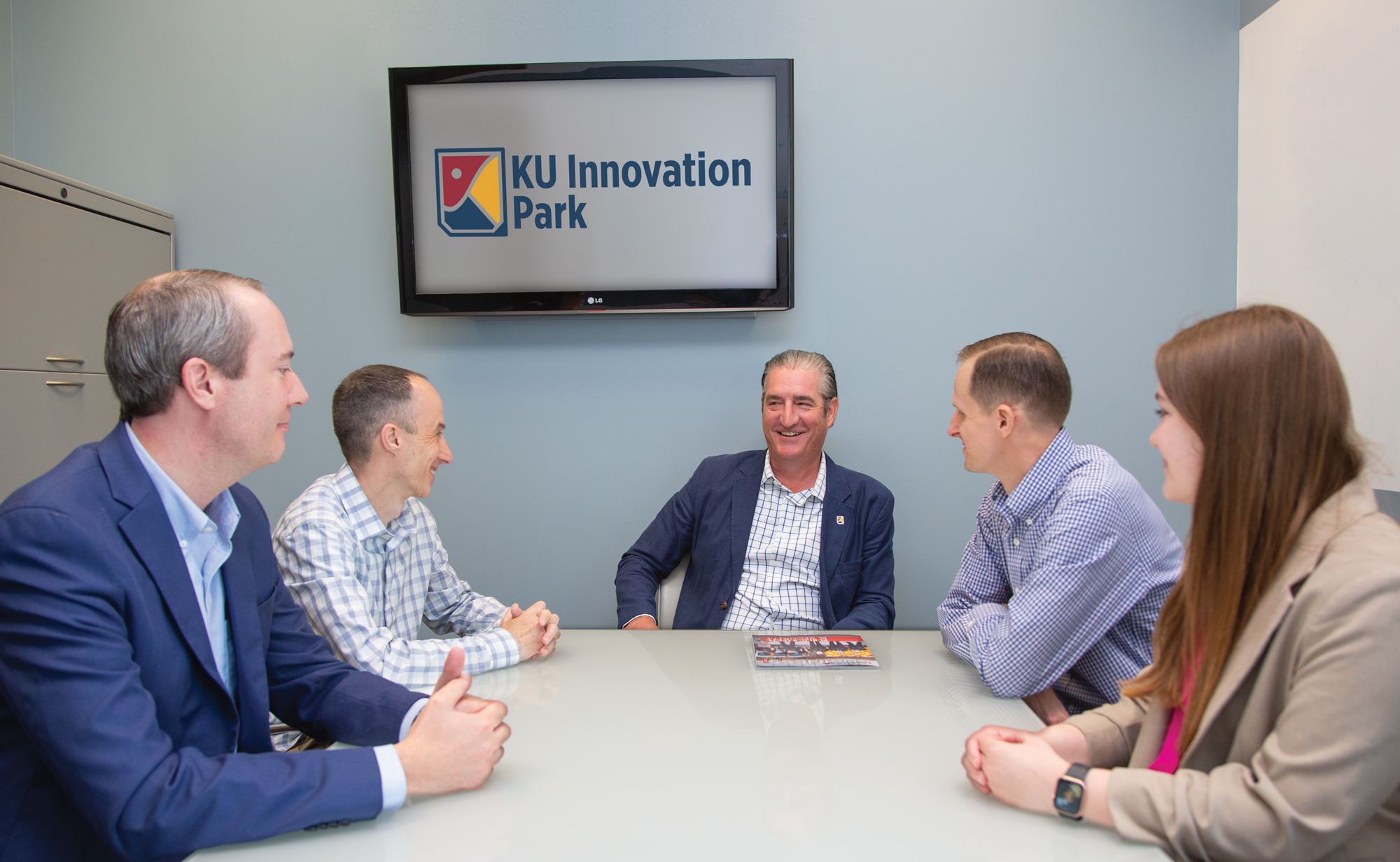
(L-R) KUIP Director of Operations-Michael Smithyman, Jason Rogers (Invary), CEO Adam Courtney, Paul Epps (Foster Care Technologies) and Claire Milroy (KUIP)
Getting Their Foot in the Door
KU Innovation Park also functions as a launching pad for students—from undergraduate research to business analysis and potential employment, it is becoming a lure for many of KU’s students.
“Students can work with hands-on applications for technology and apply it to their studies. They can have an internship year-round, try the technology and experience it. Companies can turn interns into permanent employees while seeing the academic part of the curriculum,” Courtney explains.
Bergman says students in mechanical engineering have capstone projects that are tangible problems and applied problems, where a team of students has to solve them.
“Things like that are a perfect win for the students. They learn to work as a team and get wonderful experiential learning,” she says.
The Crossing
Large-scale construction is taking place all around town and is touching KU Innovation Park, having begun in late 2023. KU Endowment is building a mixed-use development near 21st and Iowa streets called The Crossing at KU. The expected residential spaces as well as retail and dining spaces will be welcome amenities for companies at KU Innovation Park. The Crossing will be walking distance from the park. Employees always have been near restaurants and shops, but not close enough to walk. Also important for park employees is that The Crossing will contain an on-site day-care facility in the form of an expansion of KU’s Hilltop Child Development Center.
“This concept prevents brain drain in the area. Young professionals want a place to live, work and play, and hopefully this will provide a holistic lifestyle to our community,” Courtney says.
The Crossing will support existing faculty, staff and students on West Campus, as well, Bergman adds.
Settling In for the Long Haul
With two new phases coming, alongside The Crossing at KU, the park has proudly taken its place in both the stature and permanent geography of Lawrence. The evolution of research, learning and innovation is just beginning to take place there.
“There is a lot of activity in this space, and we’re grabbing the momentum. There is a lot of energy and convergence of a lot of activities. We’re seeing what we can do to take it to the next level,” Bergman says.
Johnson, having come in from the ground floor, is in awe of what the park has accomplished.
“The timing is always right if you get the right people,” he says. “Ten years from now, people won’t believe what KU Innovation Park is doing.”

